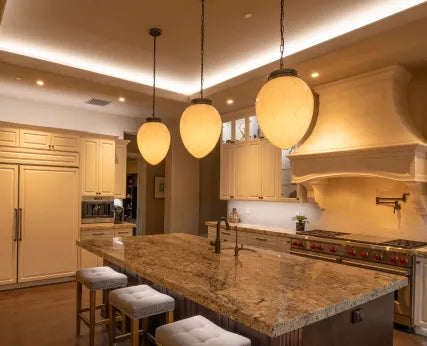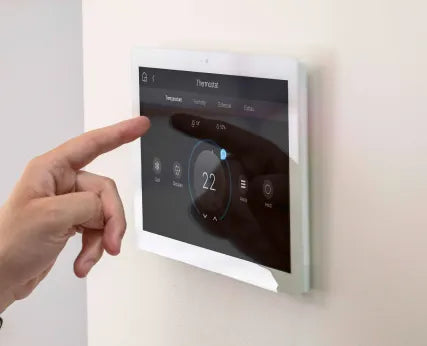Unlocking Smart Home Systems: Building a Seamless, Connected Life
Imagine this: on your way home, your smart thermostat automatically sets the temperature to your favorite level. As you step inside, smart lighting gradually illuminates your entrance to welcome you back. With a simple "I'm home," background music begins to play and the curtains close automatically. This isn’t the stuff of sci-fi movies—it's what modern smart home systems can do right now.
“Smart home” has evolved from just using a handful of smart devices to being an integrated, orchestrated ecosystem. It’s no longer about just remote control—it’s about your home anticipating your needs and actively serving you. That’s the true power of home automation.
But what separates a truly integrated home automation system from a house simply filled with gadgets? The answer lies in integration and intelligence. This guide will help you dive into smart home systems and show you how to upgrade your home from simply “connected” to truly “smart,” making your life easier, safer, and more energy efficient.
What Are Smart Home Systems and How Do They Work?
At their core, smart home systems are integrated networks that connect all your home’s devices and systems to a central hub, enabling them to communicate and act automatically based on preset rules, schedules, or real-time data.
The hub (or home hub) and connectivity protocols such as Zigbee, Z-Wave, and the emerging Matter standard form the backbone of this network. These technologies create a reliable mesh enabling various devices—lights, smart locks, thermostats, and smart cameras—to work as one system.
Instead of manually controlling each device, a smart home system can:
- Use occupancy sensors or geofencing (based on your phone’s location) to determine if you’re at home.
- Execute “scenes” or “routines.” For example, a “Goodnight” scene could turn off lights, lock doors, and adjust the thermostat with one tap.
- Respond to your instructions via voice assistants (like Alexa or Google Assistant).
- Actively manage energy efficiency by powering down devices you’re not using.
In short, it turns your home into an attentive partner that can think and act—delivering a truly responsive living environment.
Core Advantages of Having a Smart Home System
Investing in a comprehensive smart home system delivers value well beyond convenience. It brings profound benefits for both homeowners and property managers.
- Unmatched Comfort and Convenience: Automation takes care of daily chores, giving you more time to enjoy life. For example, the system can close your curtains at sunset or mimic lighting patterns while you are away to make the house look occupied.
- Significant Energy Savings: Smart management of lighting, heating, and cooling can dramatically reduce utility bills. Avoid heating empty rooms and optimize EV charging to take advantage of off-peak rates.
- Enhanced Home Security: A proactive home security network combines smart locks, smart cameras, and sensors. If something unusual happens, the system sends you an alert and can even turn on all your lights and sound alarms.
- Improved Quality of Life: From managing ventilation for better indoor air quality to creating immersive whole-home audio, automation upgrades every part of your living experience.
- Caring and Accessibility: For seniors or those with limited mobility, features like voice control and automated routines can greatly boost independence and safety.
Core Components of Smart Home Systems
A robust home automation system is built on a few key components:
- Home Hub and Protocols: This is the “brain” of your system. The hub coordinates all devices, while protocols like Zigbee, Z-Wave, Wi-Fi, and Matter are the “languages” they use to communicate.
- Reliable Networking: A stable, powerful Wi-Fi network is essential for seamless operation of wireless smart devices. For larger systems, professional network planning is vital.
- Smart Devices: These are the “hands and feet” of your setup and include:
-
- Smart lighting: Adjusts brightness, color, and schedules.
- Smart thermostat: Optimizes heating and cooling.
- Smart locks and doorbells: Control entry and monitor visitors remotely.
- Smart cameras: Deliver real-time surveillance and intelligent alerts.
- Smart curtains/blinds: Automatically open or close based on the time or sunlight intensity.
- Sensors: Detect motion, door/window status, leaks, and smoke.
Top Use Cases: Automation Integrated Into Everyday Life
The true magic of a smart home system is how seamlessly it adapts to every facet of your lifestyle.
Comfort and Convenience
Picture a “Good morning” scene: 15 minutes before your alarm, the curtains gently draw back, the thermostat raises the temperature, your coffee maker starts, and the news plays through your smart speaker.
Security and Protection
When you leave the house, the system can automatically lock doors, arm the security system, and turn off unnecessary lights. If a smart camera detects anything suspicious, it immediately sends an alert to your phone and turns on all the lights to deter intruders.
Energy Management
Your system can adjust energy consumption based on occupancy, time of day, or real-time electricity prices. For example, a smart irrigation system checks the weather forecast and skips watering if rain is expected, saving water.
Entertainment Experience
With a “Movie Night” scene, you can dim the lights, lower the projector screen, and start the sound system with one tap. A whole-home audio system lets music follow you seamlessly from room to room.
Get Interactive: Which automation scene would you be most excited to try in your home—an “Away” mode, or a “Movie Night” experience?
Integration and Interoperability: Making Everything Work Together
Historically, devices from different brands couldn’t communicate. Fortunately, the industry is moving toward unified standards.
- Matter: This emerging industry standard makes it easy for devices from different manufacturers to work together right out of the box, simplifying setup and future expansion.
- Zigbee/Z-Wave: These two mature, low-power wireless protocols are purpose-built for smart home devices, ensuring a stable, reliable mesh network.
- Wi-Fi: Many devices connect directly to your Wi-Fi network, making them easy to install, though too many can place strain on your home’s bandwidth.
Pro Tip: When building your system, choose a home hub that supports multiple protocols—especially Matter—for the greatest future flexibility.
Data Privacy and Cybersecurity: Safeguarding Your Connected Home
As our homes become more connected, protecting your data and privacy is crucial.
- Change default passwords: This is the first and most important step in protecting all your devices.
- Enable two-factor authentication: Add an extra layer of safety to your main accounts.
- Create a separate device network: Consider a dedicated guest Wi-Fi network for smart devices, separate from your main data network.
- Update firmware regularly: Manufacturers patch security vulnerabilities via firmware updates—keep all your devices up to date.
Checklist: Review all your current smart devices and make sure each has a unique, strong password.
Measuring Return on Investment (ROI)
How do you track the value of your investment in a smart home system? By using a data-driven framework:
- Key Performance Indicators (KPIs):
-
- Energy savings: Monitor reduced kWh or fuel usage.
- Reduced safety incidents: Track declines in break-ins or water leaks.
- Satisfaction: Measure improvements in lifestyle quality via Net Promoter Score (NPS) or customer satisfaction surveys.
- Analytical Framework: Compare post-installation data with baseline data from the previous year to calculate specific ROI. A professional solutions provider can help you set up and track these benchmarks.
Looking Ahead: The Future of Smart Home Systems
Smart home technologies are rapidly evolving.
- Edge AI: More intelligence will operate locally on devices rather than being cloud-dependent, enabling faster responses and stronger privacy.
- Predictive Maintenance: Your home will be able to notify you when it’s time to change an air filter or even warn you before the water heater fails.
- Energy Orchestration: Systems will intelligently interact with the grid, leveraging solar panels, home batteries, and EVs to optimize energy generation, storage, and usage.
- Digital Twins: A digital replica of your home in the cloud will help model and optimize automation strategies before deployment in the real world.
Partner with Linko Smart Technology
Designing and installing a seamless, reliable, and secure home automation system requires experience and expertise. Every step matters—from networking and device selection to complex scene programming.
At Linko Smart Technology, we’re end-to-end experts in smart home systems. We start by deeply understanding your lifestyle and goals, then design a fully customized system, provide professional installation and setup, and ensure you enjoy all the benefits that smart living has to offer.
Ready to upgrade your home into a truly intuitive smart partner? Contact Linko Smart Technology now for a free consultation or to plan your smart home systems project!
Frequently Asked Questions (FAQ)
1. How much does it cost to deploy a full smart home system?
Costs vary greatly depending on your home size, the number and brands of devices, and the complexity of your automation. You can start with a single room or feature (like smart lighting) and gradually expand. We focus on maximizing your value.
2. Can I add a smart home system to an older house?
Absolutely. There are a wide range of wireless devices and solutions designed specifically for retrofits, with no need for invasive rewiring.
3. How long does installation take?
A basic system can be set up in just a few hours. A whole-home automation project may take a few days, depending on size and complexity. We’ll provide a clear timeline.
4. What kind of maintenance is required?
Most modern smart home devices require little to no physical maintenance. The main task is keeping software and firmware up to date, which typically happens via the app or can be managed remotely by us.
5. DIY vs. professional installation: how do I choose?
DIY is an option for tech-savvy users wanting to try a few standalone devices. For a truly integrated, reliable system—especially one combining many devices and protocols—we strongly recommend professional installation. Experts ensure robust networking, full compatibility, and advanced automation programming so you unlock your system’s full potential.
6. Are my data and privacy safe?
We prioritize your privacy. We work only with reputable brands providing robust cybersecurity features and transparent privacy policies. Professional installation also includes all necessary security steps, like dedicated networks and strong passwords, to protect your system from unauthorized access.




